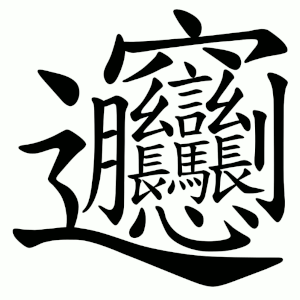𰻞
- famous noodle dish;
A rare, nonstandard character used in 陝西 방언 for the famous noodle dish biángbiángmiàn (뱡뱡면). It does not have any traditional semantic meaning apart from denoting this food.
Etymology
This combines elements like 穴 (cave), 言 (speech), 幺 (silk thread), 馬 (horse), 長 (long), 心 (heart), 月 (flesh/moon), 刂 (knife), and 辶 (walk).
Component breakdown:
Origin & folklore:
According to folk etymologies, the character may have been invented to represent the sound of dough being slapped when making wide Shaanxi noodles.
Some claim it was coined by the Qin dynasty minister Li Si, but no early evidence survives.
In practice, it was likely created by noodle vendors in Shaanxi to market the dish.
Stroke count and sheer complexity made it famous; it is often described as “the most complicated character in use,” although technically 𪚥 (64 strokes) has more.
Its exotic form even inspired songs and mnemonics for memorization.
Usage in Korean
Additional notes
𰻞 has become a pop-cultural curiosity in modern China:
Featured on TV shows and tourist signage in Xi’an.
A Shaanxi university professor once punished a late student by making him write the character 1,000 times — the student managed ~200 before giving up.
Online communities (like 아카라이브) have gamified it, challenging people to write it as many times as their “likes.”
Its sheer complexity makes it a symbol of Chinese script’s visual extravagance.
Alternative forms
Multiple variations exist; see 𰻞𰻞麵/ 𰻝𰻝面 on the Chinese Wikipedia. Wikipedia zh
- 卜十金心 (YJCP)
- ⿺ 辶 ⿳ 穴 ⿲ 月 ⿱⿲ 幺 訁 幺⿲ 長 馬 長 刂 心
